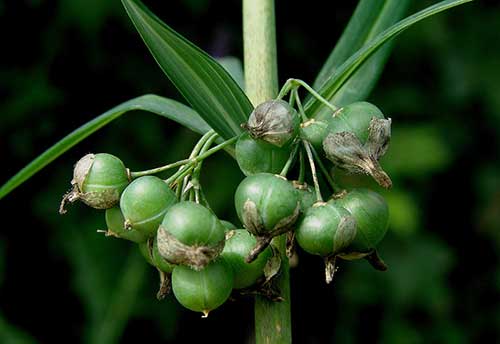- Araliaceae
- Asteraceae
- Campanulaceae
- Caryophyllaceae
- Elaeagnaceae
- Ephedraceae
- Gentianaceae
- Ginkgoaceae
- Guttiferae
- Labiatae
- Leguminosae
- Liliaceae
- Magnoliaceae
- Malvaceae
- Oleaceae
- Orchidaceae
- Orobanchaceae
- Palmae
- Poaceae
- Polygalaceae
- Ranunculaceae
- Rutaceae
- Sarraceniaceae
- Schisandraceae
- Scrophulariaceae
- Solanaceae
- Taxaceae
- Theaceae
- Thymelaeaceae
- Umbelliferae
- Valerianaceae
- Zingiberaceae

Polygonatum
- Introduction
- Published data
- Download
The rhizomes of Polygonatum species of the family Liliaceae have a long history of use in traditional medicine in Asia.1 Approximately 40 species have been identified in eastern Asia, of which are found in Korea. They have various medicinal effects by species and are used in different ways in Asian medicine. Polygonatum odoratum var. pluriflorum Ohwi and related species are commonly used as a tonic remedy as well as to treat painful conditions, cardiac exhaustion and age spots.
Pubulications:
Lee M Y, Moon B C, Kwon Y K, et al. Discrimination of Polygonatum species and identification of novel markers using 1H NMR‐and UPLC/Q‐TOF MS‐based metabolite profiling[J]. Journal of the Science of Food and Agriculture, 2016, 96(11): 3846-3852.
Details:
http://herbalplant.ynau.edu.cn/index.php?m=content&c=index&a=show&catid=100&id=183

Allium sativum
- Introduction
- Published data
- Download
Garlic (Allium sativum) is a traditional cultivated plant which is used widely in culinary foods and utilized as a folklore medicine throughout human history. Advantages and beneficial effects of garlic (Allium sativum) consumption have been widely investigated, eliciting great interests especially for medical researchers. Beneficial health effects include decreased susceptibility to heart attack and reduced glucose and cholesterol levels in blood.
Pubulications:
Huang C H, Hsu F Y, Wu Y H, et al. Analysis of lifespan-promoting effect of garlic extract by an integrated metabolo-proteomics approach[J]. The Journal of nutritional biochemistry, 2015, 26(8): 808-817.
Details:
http://herbalplant.ynau.edu.cn/index.php?m=content&c=index&a=show&catid=100&id=182

Bulbus Fritillariae ussuriensis
- Introduction
- Published data
- Download
Bulbus Fritillariae ussuriensis is the well-known food and folk medicine distributed in the Northeast Provinces of China, such as Liaoning, Heilongjiang and Jiling provinces, because it has remarkable antitussive, expectorant and antiasthmatic activities.
Pubulications:
Wang L, Yao Z P, Li P, et al. Global detection and semi‐quantification of Fritillaria alkaloids in Fritillariae Ussuriensis Bulbus by a non‐targeted multiple reaction monitoring approach[J]. Journal of separation science, 2016, 39(2): 287-295.
Details:
http://herbalplant.ynau.edu.cn/index.php?m=content&c=index&a=show&catid=100&id=181

Anemarrhena asphodeloides
- Introduction
- Published data
- Download
The rhizomes of Anemarrhena asphodeloides Bunge (Liliaceae) have been widely used in China, Japan, and Korea as an ingredient in herbal medicines. This plant has been reported to have anticancer, antidiabetic, antifungal, antiplatelet aggregation, antiviral, and neuroprotective activities.
Pubulications:
Kim N, Ryu S M, Lee D H, et al. A metabolomic approach to determine the geographical origins of Anemarrhena asphodeloides by using UPLC–QTOF MS[J]. Journal of pharmaceutical and biomedical analysis, 2014, 92: 47-52.
Details:
http://herbalplant.ynau.edu.cn/index.php?m=content&c=index&a=show&catid=100&id=180